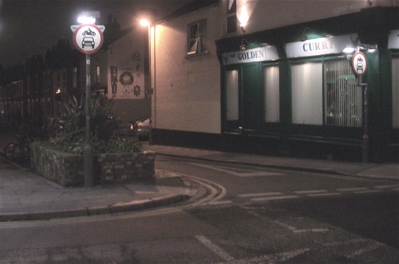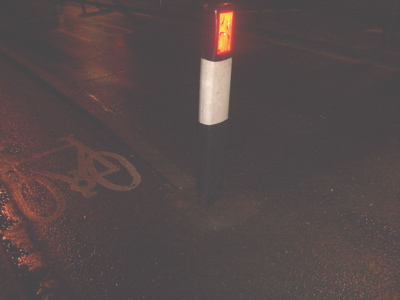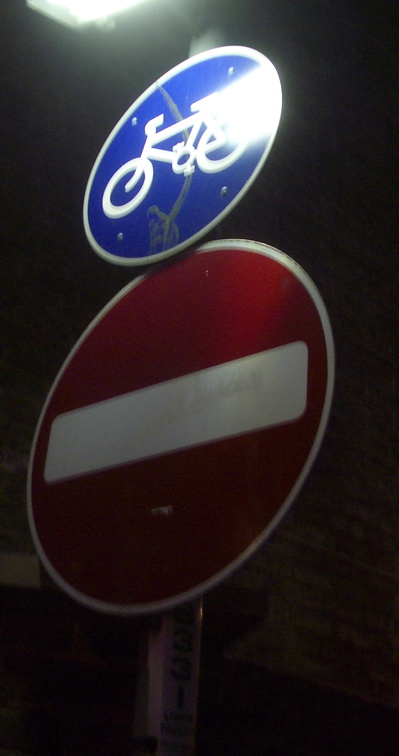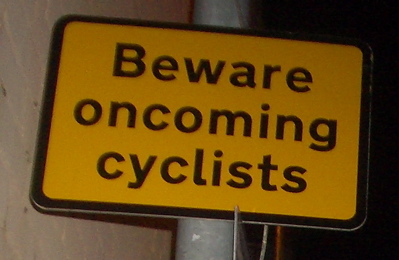
I have just returned from a public meeting held at St. Barnabas Church, Mill Road about how “contraflow cycling” on some of the streets off Mill Road should be indicated in the way of signage, road markings, islands etc. Contraflow cycling is where cyclists are allowed to travel in both directions on roads which are one-way only for motorised vehicles.
Some background information is contained within the City Council’s consultation leaflet which contains the County Council’s plans and my post on Two Way Cycling on One Way Streets which I wrote before the meeting.
Highlights:
- There was unanimity about the need for no-entry signs to return to the the entrances of the one way roads off Mill Road, because motorists were not obeying the no-motor vehicles signs.
- Labour councillors who had published a leaflet opposing contra-flow cycling in these streets did not stand up at the meeting and say that was what they wanted and try and defend their stance. They accepted they were in a minority and decided instead to focus on how to best run the contraflow system safely. Cllr Bradnack confirmed to me that he was very much still against contraflow cycling in these streets and the meeting had not softened his opposition.
- Despite the county council officers having a key role in determining if various proposals are acceptable from a point of view of legality and safety none of the county council officers invited attended.
- Two residents said they had spotted police cars disobeying the no motor-vehicles signs. Other offenders who residents thought ought know better included Royal Mail and Taxis.
- Cllr Bradnack summed up the meeting quite effectively saying that the residents present were reporting problems (cars going though the no motor vehicles signs etc.) and the cycling campaign members present were offering solutions (ideas for clear and legal road layouts and signage).
Threats and Inconsistency

The County Council, we were told, were insisting that a whole raft of onerous legislation had to be precisely adhered to in whatever scheme was proposed. One of the ways to have no entry signs for traffic and still allow cycles is to introduce an island in the road separating the cycle way from the rest of the traffic. With this arrangement no entry signs can be placed either side of the roadway (one on the island), and a blue cycleway sign used to mark the cycleway. The county council though are being awkward, insisting that any such islands are very wide. They claim this is necessary to protect the sign in the middle. Their officers are also apparently unwilling to accept other ways of signing “no entry except cycles” which may be judged illegal. Opposition to practical solutions for these streets was noted to be out of line with what has been accepted elsewhere. For example the island on Bridge Street (pictured) is only one curbstone wide, and on Malcolm Street cyclists are encouraged to go through a no-entry sign by the presence of a blue cycle way sign directly above it. Corn Exchange Street was also given as an example.

The most shocking statement of the evening came from Nichola Harrison, Liberal Democrat councillor for Petersfield on Cambridgeshire County Council. In Cambridge many local transport decisions are delegated from the County Council to local City and County Councillors at a “Area Joint Committee (AJC)”. Cllr Harrison said that this delegation of powers might be removed if local councillors proposed works which were be viewed as potentially illegal by officers. Another threat was reported to the meeting by Clare Rankin, one of Cambridge City Council’s Cycling and walking promotion and development officers. This second threat was that if too much fuss is made over requests for signage indicating no-entry except for cyclists in these streets off Mill Road, then the contraflow cycle lane on Malcolm Street would be removed (it is almost certainly non-compliant with legislation). Cllr Colin Rosenstiel explained this lane went in when the City Centre cycling ban was imposed to provide a way round. Clearly this lane is very useful and well used and its loss, over petty political bickering would not be accepted by the people of Cambridge. A number of people at the meeting including Cllr Bradnack suggested our local councillors should call the County Council’s bluff on this one.
Cllr Lucy Walker said that the County Council had said that they would go with whatever local councillors wanted. A member of the public said she’d contacted County Council officers and had been told the same. Cllr Harrison explained that if the AJC requested something that was legally in a grey area officers would almost certainly block it. A number of those present said that it should be elected councillors not officers making such judgements. Cllr Harrison said that if something non-standard was requested it would be taken to the County Council’s cabinet, who were described as conservatives representing rural wards miles away from Cambridge, and it was thought would probably refuse any scheme with non-standard elements. The need to campaign for changes to the legislation was made clear.
At this meeting, as often happens at public meetings, members of the public expressed their annoyance and frustration about party political considerations being debated. I don’t believe party politics adds any value to local government, especially when as in Cambridge many local politicians don’t support many of their party’s national policies. But then people elect members of political parties to represent them. Not all by any-means realise they don’t have to.
Mackenzie Road
The proposals, which can be seen in the consultation leaflet were largely approved of by those present.
Comments were made on the width of the cycle lane though, with members of the cycling campaign noting it ideally should be wider, but given it was such a small stretch this wasn’t too much of a worry. At this point no-one considered the possible large numbers of students using this route at the same time once the student residences on the station redevelopment site are in operation.
Kingston Road
A resident reported that she estimated about 3 vehicles an hour entered the road illegally.
The problem of cyclists coming down the hill off the railway bridge making an illegal turn into Kingston Road was raised. There was a suggestion that the no right turn sign was not particularly visible. One member of the public suggested Darwinian action would solve this problem given time.
Given the desire of those present at the meeting to have a layout at Kingston Road more like that proposed for Mackenzie Road, with the cycle lane on one side of the planter and the main carriageway on the other, the future of the planter was discussed. Cllr Harrison suggested this was a very local question for residents of that street to decide the value of the planter to them. Cllr Kevin Blencowe pointed out it served a function of making it even clearer to motorists that they shouldn’t try and drive down this street from the Mill Road end. I think the general consensus was that a new, smaller planter would be preferable.
Frank Gawthrop pointed out the sums of money likely to be needed to be spent on Kingston Road, to achieve what was now being proposed would become significant. He pointed out that this scheme was not being coordinated with the proposals to calm traffic on Mill Road, or with the traffic works in the area which will accompany the station area CB1 redevelopment. Introducing a cycle activated crossing, with traffic lights on Mill Road at this point would was an example of something which might be considered as part of these broader schemes. Though problems with siting this at the bottom of the bridge were raised. I think this lack of co-ordination between these three sources of money, and three schemes all affecting the same area is a recipe for wasting public money through getting things wrong and having to undo recently completed works.
Cllr Bradnack, and a resident both put forward advantages of moving parked cars on Kingston Street to the other side of the road. This would allow the cycle lane to continue much further down the road in a straight line. The other advantage was that, this being a one way street, all the cars have to, by law, park facing the right way, and this would mean passing cyclists passed cars on their drivers’ side, which meant they could see cyclists more easily when pulling out. This appears to me to be a very sensible suggestion.
There was a lot of support for the cyclists line of desire at the other end of Kingston Street to cut though towards Sturton Street to be recognised. The proposal was for a give way sign and road markings on Hooper Street giving cyclists the right of way. A few people noted that drivers currently go round this blind corner far too fast.
People pointed out that Kingston Road was on a route to the railway station used by many people, not just from the immediate area, but those coming from the Newmarket road area and beyond. This was used as a reason for broadening consultation, and not limiting it to just local residents.
Mawson Road
A cycling campaign member suggested there was room do “do it properly” here too, with an island with a sign on it with a cycle way to one side. The challenge of allowing large vehicles access was could be met by moving the island and sign back into the street slightly if required.
A Mawson Road resident said she experienced 5/6 cars per hour going the wrong way down the street.
Covent Garden
A member of the Cycling Campaign said that the traffic sign regulations permitted just one No Entry sign to be used if a road was less than 5m wide. There was a discussion if this helped or not. Cllr Walker suggested, logically, that the legal effect of that single sign would be the same as two, so you wouldn’t be able to cycle past it, even in a cycle lane on the other side of the road. The person making the observation replied: “even with a solid white line?”. Everyone appeared to think we’d then be in the realm of a grey area. Again the point was made that the AJC would have to be careful making such a suggestion as it might result in the delegation of power to them being rescinded.
One resident of Covent Garden, who I spoke to after the meeting on the street as I went to investigate the array of signage in more detail brought photographs of car parking chaos, cars blocking the cycle lane. There was an unresolved discussion about the exact nature of the street, is it a one way street, or a “false one way street”. I think the confusion arose, as even some of those who had sat though well over an hour of this discussion were on occasion considering the “no motor vehicles” sign to be “except for access”, when it only in fact has that “except for access” exception when such a plate is attached. Clearly this is how motorists photographed going the wrong way on the street interpreted it too. There is a clear “left turn” only sign at the Mill Street, Covent Garden junction, and clear one way arrows at the Mill Road junction.
The possibility of painting “No Entry” on the road, at the Mill Street / Covent Garden Junction was discussed, and considered reasonable by those present.
General Comments
- There were complaints from a number of people that they had not been consulted by the council about the plans, they had heard only via the Cycling Campaign
- Despite the meeting accepting that contraflow cycling was to continue. Cllr Harrison still put forward one case for it, saying it lets people avoid cycling on the dangerous Mill Road. (I believe introducing the contraflow to Collier Road would help some ARU students avoid a stretch of Mill Road too). One resident gave another reason in favour of contraflow cycling, it meant she could legally take the direct route from her home onto Mill Road.
- Cllr Harrison suggested a local leaflet drop telling people what the signs meant. This was not a popular suggestion. Someone suggested publicity in “Cambridge Matters”, to which Cllr Blencowe quipped: “I thought that was for ReCycling, not Cycling”. Frank Gawthrop thought a better alternative would be to prosecute some offenders and publicise their prosecution in the newspapers. He got a round of applause for this suggestion. He also noted that there was already CCTV covering some of the junctions, and if the police were inclined they could use it as evidence in prosecutions [or at least for warning letters]. Cllr Rosenstiel suggested that he, and other residents attended the East Area committee when the police were present to put their suggestion to them directly. I think it would be a first if the police accepted a suggested priority from the public at such a meeting, and I cannot see why Cllr Rosenstiel could not have taken this suggested priority from this meeting to the East Area committee himself, without requesting members of the public to attend and do it themselves. It appears common that our Liberal Democrat councillors in Cambridge are reluctant to represent constituent’s views when it comes to policing. (Cllrs Blair and Huppert in East Chesterton directly have refused to present the views of the East Chesterton Ward Police meeting to the North Area Committee.)
- Cllr Harrison drew attention to a forthcoming Government review of road-signs.
- A resident of Mackenzie Road said she had taken the number plates of some of those driving the wrong way down the street, she told the meeting that these had been passed to the police and she had been told they would be receiving warning letters from the Police. She said that one of the numbers she noted down was of a police car, she said that the driver, when questioned had said he didn’t understand the no motor-vehicles sign.
 Another resident noted the presence of the “Beware oncoming cyclists” sign, and suggested more signage along those lines. This prompted others to note the locations of similar warning signs, some aimed at drivers, others at cyclists. This received some support as an inexpensive suggestion that might improve safety. Though the balancing concern about too many signs was also raised.
Another resident noted the presence of the “Beware oncoming cyclists” sign, and suggested more signage along those lines. This prompted others to note the locations of similar warning signs, some aimed at drivers, others at cyclists. This received some support as an inexpensive suggestion that might improve safety. Though the balancing concern about too many signs was also raised.- There was scepticism from many, even from the City Council’s Executive Councillor in charge of waste collection Cllr Rosenstiel, about claims that refuse vehicles tracking as they left these streets was something limiting the size of the roadway.
- A resident asked whose job it was to inform Sat. Nav. companies about the fact these were one way streets. Cllr Harrison committed to check. Members of the public suggested they would get their data from sources such as the ordnance survey.
- The possibility of painting “No Entry” on the road at various places was discussed, in one case painting it on Mill Road adjacent to the one way streets was suggested
- Martin Lucas-Smith of the cycling campaign, on the question of removing the contraflow entirely, said: “Those cycling legally should not suffer due to the actions of motorists driving illegally”.
- Cllr Rosenstiel said he liked the cycling campaign’s concept of a sign on which a rectangular panel contained both the no entry and the cycle way sign, with a solid line between the two.
- It was noted that double yellow lines had been painted in Mawson Street on the cycle way, but not in Covent Garden. Councillors said the fact the crew had been out and done one street and not the other was “unbelievable”. Members of the public asked why yellow lines were needed when it was already an offence to obstruct the cycleway, the meeting was told that for traffic wardens to enforce this they needed double yellow lines, otherwise only the police could take action against parked cars.
Confusion
Towards the end of the meeting Cllr Blair passed a Christmas card to Cllr Blencowe, he looked confused and astounded.
3 responses to “Public Meeting – Two Way Cycling on One Way Streets”
From a transport infrastructure viewpoint, why is Cambridge not like Copenhagen? Or Assen? Or Offenburg?
Here is your answer. Petty small-minded politics failing to address the big picture.
It is the death by a thousand cuts.
Hi Richard. It really is about time that Cambridge started to come to terms with the existence of the bicycle, with the idea that it should be a mode of transport which is promoted rather than made difficult, and with what is required to make cycling more convenient and therefore more attractive to people.
We moved to Assen in the Netherlands, where there are many one-way streets restricting the movement of motorists. However, every single one of which has cyclists excepted from the one-way restriction. I’ve just written on my blog about this, referencing this post.
Your excellent writeup missed one notable exchange:
Cllr Ben Bradnack objected to cyclists speaking at the meeting as he felt the matter was properly only for consideration by residents of the specific streets affected. This view didn’t seem to gain general support in the meeting and was rejected by the officers and (other) councillors.